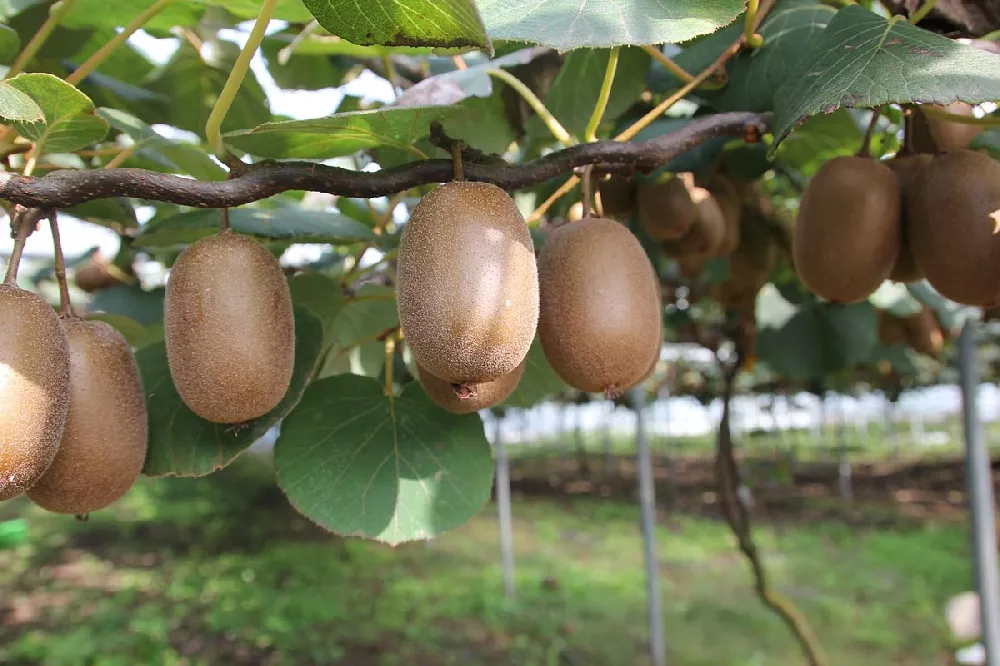Fuzzy Kiwi Plants for Sale - Buying & Growing Guide
Fuzzy kiwis, Actinidia deliciosa 'Hayward,' are well-known for their vibrant green (and, of course, fuzzy) fruit, which are rewarding on their own or in fruit salads or other recipes. But what supermarket shoppers don't realize is how attractive the plants themselves are and what a great addition they are to a landscape. These woody vines can be trained to grow up a trellis or over a fence, and they can even form a living privacy fence. Here are a few more reasons to love fuzzy kiwi plants:
- The vines can grow up to 15 to 20 feet long and are easily trained to trellises or other structures.
- The fuzzy kiwi has few natural pests or diseases, and the vines are easy to care for once established.
- The fuzzy kiwi plant has attractive, heart-shaped leaves and small, white, fragrant flowers.
Enter your zip code to find nearby stores that may carry this plant.
Plant Care
Sunlight

Fuzzy kiwi prefers full sun, but can handle some shade, especially at the southern end of its range.
Watering
Water thoroughly during the first year and whenever the ground seems dry or parched.
Fertilizing

Fertilize during the growing season with a nitrogen-rich product designed for fruiting plants.
Planting and Care
Planting instructions
Site your fuzzy kiwi plant in a spot that gets good sun and has fertile, well-draining soil. You’ll have best results if your soil has a pH between 5.5 and 6.5. Add sulfur if it is higher than this range.
If you are planting in the hopes of harvesting fruit, you will need at least one male plant for every eight female plants. Space plants 15 feet apart. Dig a hole that’s slightly deeper than the root ball and twice as wide. Unpot the plant, and tease out encircling roots, which can girdle the tree and slowly kill it. Add some well-rotted manure or compost to the hole, then place the vine in the hole so that the top of the root ball is level with the ground. Fill in around the root ball with soil, tamping down as you go to eliminate air pockets. Water thoroughly.
Watering and nutrients
When newly planted, water your fuzzy kiwi several times a week or whenever the soil seems dry. Once established, you can cut back on supplemental watering, but monitor the vines carefully: if you see signs of drooping leaves or you’re experiencing dry conditions, give your vines a good watering. Fertilize throughout the growing season with a balanced, slow-release product as indicated by package directions. If you see leaves turning pale green or yellow, try a fertilizer with a higher ratio of nitrogen.
Pollination
Fuzzy kiwi vines are dioecious, meaning that male and female reproductive parts are on different vines. If you want to harvest fruit, therefore, you’ll need to purchase at least one male and one female vine and plant them near each other. The flowers are pollinated by insects, and the more pollen the insect leaves on the flowers, the larger the fruit will be.
Pruning
Fuzzy kiwi vines need regular pruning to produce the best fruit. You will need to train your vines up a trellis or other structure, pruning out all except a strong single trunk, with regularly spaced branches leading off of it. The best time to prune male vines is just after they bloom, while female vines are best pruned in the late winter, before bud break. You should also remove suckers around the base of the trunk, as well as diseased or broken branches, whenever you see them.
Pests and diseases
Few insect pests bother fuzzy kiwi plants. Possible diseases include phytophthora root rot, which is more pronounced in heavy soils and is best dealt with by planting your vine in soil that drains well. You may also see signs of verticillium wilt, a fungal disease that will eventually kill your vine — there is no cure for this disease. Avoid planting your fuzzy kiwi plant in a spot where berry plants or members of the nightshade family (such as tomatoes, peppers, potatoes, and eggplants) have grown in the past.
Harvesting
It can be difficult to determine when kiwi fruit is ripe, and most experts recommend that you leave the fuzzy fruit on the vine until just before your first hard frost. They will continue to ripen after being picked and should be stored in a chilled location away from other ripening fruit, such as in a garage or cold basement.
FAQs
How many years will it take for my fuzzy kiwi plant to produce fruit?
That depends partly on the age of the vines you plant. Assuming they are 1-year-old vines, you can expect them to begin a light fruiting after their third year. Female vines become mature before male vines, so it helps if your male vines are older. Your first-year crop will be very light; it may take a few years before you are able to harvest a robust crop.
What zones are best for my fuzzy kiwi plant?
Fuzzy kiwi plants are best grown in USDA Hardiness Zones 7 to 10. They are native to warmer regions in eastern Asia and cannot take regular hard frosts.
Can fuzzy kiwi plants be grown in containers?
Yes, they can, though they will generally not grow as big as they would when planted outside; you may also find that they do not fruit as generously or regularly.
Are fuzzy kiwi vines self-fertile?
Strictly speaking, yes. But you will only be able to harvest a sizable crop if you have male and female plants growing near each other. This will lead to a much better pollination rate, and, later, more fruit.
Compare Similar Products
You can't add more Product Name - Product size to the cart.
OK









